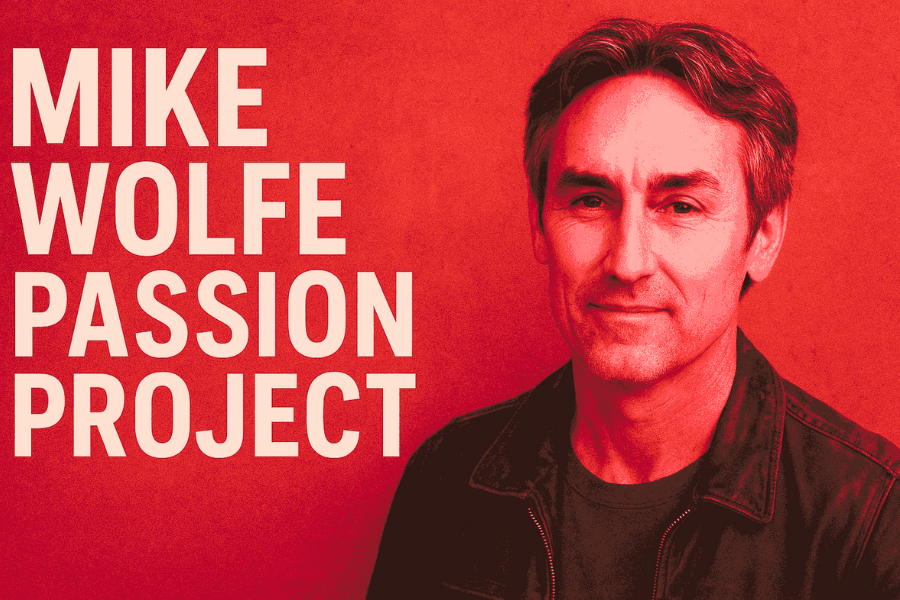You know him as the charismatic “picker,” the guy who can spot a diamond in the rough from miles away — the man who has turned rusty signs, forgotten bikes, and vintage Americana into a cultural phenomenon. Mike Wolfe, the face of American Pickers, built his career around the hunt — unearthing hidden treasures buried under decades of dust in barns, garages, and forgotten backyards across America.
But what happens when the ultimate “find” isn’t a collectible object, but an entire building? When the pick itself becomes the foundation for something far greater — a revival of history, community, and soul?
That’s exactly what Wolfe has set out to do in Columbia, Tennessee, where his latest project — the restoration of a once-abandoned 20th-century gas station — is turning heads. This isn’t a TV stunt or a vanity investment. It’s a passion project in the truest sense: a living embodiment of Wolfe’s lifelong philosophy that every old thing has a story worth saving.
The Find: Breathing Life into Forgotten Places
Picture this: an old brick gas station, long silent, standing guard over a small-town street corner. Its windows are clouded, its roof sagging, and the air around it thick with nostalgia. For years, this structure sat quietly in downtown Columbia — a reminder of an era when road trips were adventures, and every fill-up came with conversation.
Most people drove by without a second thought. To the untrained eye, it was little more than an eyesore — another relic waiting for a bulldozer. But Mike Wolfe isn’t most people. Where others saw a teardown, he saw a treasure.
To him, this gas station was not just a structure; it was a story waiting to be retold. Every faded paint layer, every rusted pump, and every crack in the foundation whispered something about the generations that had passed through. Wolfe saw beyond the decay — he saw potential.
In true picker fashion, he didn’t focus on what it was. He envisioned what it could be. A gathering space. A place filled with laughter, light, and purpose. He imagined a fire pit where people could share stories, an outdoor courtyard echoing with live music, and a community hub that celebrated local history rather than erasing it.
Beyond the Show: The Heart Behind the Restoration
American Pickers has always showcased Wolfe’s sharp eye for valuable finds and his respect for history. But beneath the surface of that show lies a deeper motivation that drives him — a genuine reverence for craftsmanship and heritage.
This project in Columbia represents the next evolution of that passion. It’s not about flipping an antique for profit or scoring a TV-worthy discovery; it’s about stewardship. Wolfe has spent decades rescuing pieces of America’s past one object at a time. Now, he’s doing it one building at a time.
“Preservation is really about storytelling,” Wolfe has often said in interviews. “When we save these places, we’re saving the spirit of the people who built them.”
And that’s exactly what this gas station project — now known as Revival — represents. It’s not just a business. It’s a statement. It’s Mike’s way of saying that progress and preservation can coexist, that history doesn’t have to be paved over in the name of modernity.
For Wolfe, the thrill of the hunt has transformed into something more enduring: a commitment to honoring the craftsmanship, spirit, and ingenuity that built America’s small towns.
The Vision: Turning History Into a Modern Landmark
Executing a dream like this isn’t as simple as applying a fresh coat of paint. Historic restorations require sensitivity, patience, and respect for the building’s original character. To bring Revival to life, Wolfe collaborated with a specialized design and construction team familiar with adaptive reuse — a process that reimagines old spaces while preserving their essence.
Adaptive reuse is more than renovation; it’s translation. It takes the language of the past and rewrites it for modern audiences while keeping the original voice intact.
In Revival, that meant keeping the original brick façade, repairing rather than replacing materials wherever possible, and highlighting the structure’s authenticity rather than hiding it. Inside, the function has been reimagined. Instead of pumping gasoline, the space will now “fuel” people in a different way — through good food, craft cocktails, and community energy.
The outdoor seating, warm fire pit, and ambient lighting create a welcoming environment — a deliberate choice to encourage connection. Wolfe understands that the heart of any town beats strongest in the places where people gather.
Revival vs. Renovation: The Difference in Philosophy
To appreciate the depth of this project, you have to understand what sets it apart from a standard commercial development.
| Feature | Mike Wolfe’s “Revival” Project | Typical Commercial Renovation |
| Goal | Preservation, storytelling, community building | Profitability and modernization |
| Design Approach | Adaptive reuse; retain original character | Tear-down or full replacement |
| Materials | Reclaimed, historic, authentic | Cost-effective, standardized |
| End Result | A landmark with soul and story | A functional but generic space |
| Community Impact | High; creates a shared gathering point | Variable; often minimal |
The difference lies in the why. While most developers focus on revenue, Wolfe’s goal is to create emotional and cultural value. His success is measured not in dollars but in dialogues — in the number of people who stop by, feel inspired, and reconnect with their town’s heritage.
Why “Revival” Matters More Than You Think
It’s easy to view Revival as just another trendy restaurant or bar. But that perspective misses the point entirely. This project is a microcosm of a much bigger idea — that history can fuel the future.
By restoring rather than replacing, Wolfe is setting an example for other creators and investors. He’s showing that historic buildings can be both beautiful and functional, nostalgic and profitable, old and alive.
The impact of projects like this extends far beyond the property line. Economically, it can boost tourism and foot traffic, inspiring other entrepreneurs to follow suit. Culturally, it reaffirms the town’s identity, reminding residents that their history isn’t disposable. Socially, it creates what urban planners call a “third place” — a community hub where people can connect outside of home and work.
For a place like Columbia — known as the “Antique Capital of Tennessee” — Revival is both a love letter and a rallying cry. It celebrates the town’s vintage charm while pushing it into a vibrant new chapter.
The Ripple Effect: One Building, Many Beginnings
One of the most remarkable aspects of passion projects like this is their ripple effect. History shows that a single restored building can act as a catalyst for broader change. When locals see what’s possible, it inspires others to invest, restore, and beautify their own properties.
Already, Columbia has experienced a cultural resurgence in recent years — fueled in part by creatives and preservationists like Wolfe who believe small towns still have big potential. The success of Revival could encourage even more investment, sparking a domino effect that breathes life into surrounding shops, sidewalks, and neighborhoods.
In that sense, Revival isn’t just a bar or a landmark — it’s a spark. A reminder that progress doesn’t have to erase the past; it can evolve from it.
The Legacy: A Modern Lesson in Stewardship
At its core, Mike Wolfe’s passion project in Columbia is about stewardship. It’s a declaration that preserving history is not about clinging to what was — it’s about enriching what can be.
He’s taken the same instincts that made him a master picker — curiosity, respect for craftsmanship, and an eye for untold stories — and scaled them up to the level of architecture and community.
The end result, Revival, isn’t just a name. It’s a metaphor — for rebirth, for continuity, for rediscovering beauty in what’s been overlooked.
In an age of disposable everything, Wolfe reminds us that the greatest treasures aren’t the ones we buy or sell — they’re the ones we rebuild together.



